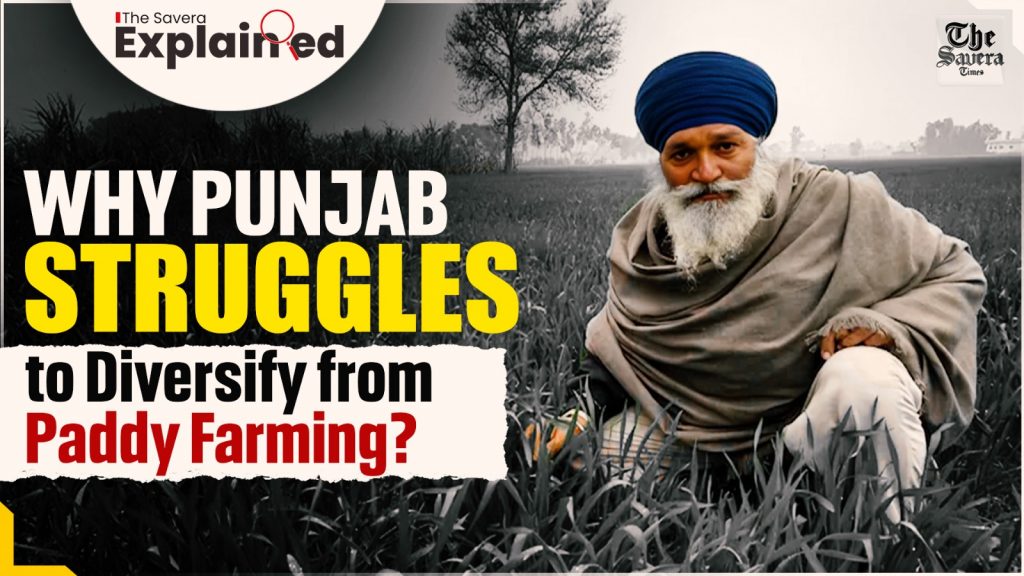Punjab, India’s third-largest crop-producing state, is renowned for its robust irrigation system. It also ranks third in food grain production. But do you know, the state has been facing challenges in diversifying itself from paddy farming?
According to recent data, the state covers about 32 lakh hectares in 2025, nearly 91% of the kharif crops. Despite government efforts to grow other crops like maize, pulses, or vegetables, farmers keep choosing paddy. This causes problems like
- water shortage
- soil damage
- air pollution
- Groundwater Depletion, etc.
Let’s talk about these challenges in detail:
- Groundwater Depletion: Paddy’s high-water demand (22–30 irrigation cycles) overexploits 75% of Punjab’s groundwater, worsened by the 2025 early sowing policy.
- Soil Degradation: Monoculture depletes soil nutrients, reducing fertility.
- Air Pollution: Stubble burning, intensified by short harvest windows post-2009 Act, pollutes northern India.
- Economic Dependence: MSP (₹2,320/quintal in 2024) and procurement favor paddy, discouraging diversification to maize or cotton.
- Procurement Issues: Delays in 2024 caused losses; banned varieties like Pusa-44 persist due to high yields.
- Policy Conflicts: Subsidies promote paddy, countering diversification.
- Labour and Climate: Heatwaves and unseasonal rains in 2025 raised costs and damaged crops.
- Environmental Impact: Diseases and resource strain threaten sustainability.
Reportedly, around 35-36 lakh hectares are under cultivation in Punjab during the kharif season (June to October). Last year, this figure was 35.2 lakh hectares.
The main crops during the kharif season are paddy (including basmati and non-basmati), cotton, maize, certain pulses (like moong, urad and arhar), oilseeds (like groundnut and sesame), and sugarcane, which is cultivated all year round.
But paddy accounts for the vast majority. It witnessed a production scale of more than 92% last year, compared to all other crops.
Growing the same crops year after year on the same land increases vulnerability to pest and disease attacks. Paddy cultivation specifically depletes soil nutrients, which increases dependence on chemical fertilisers and pesticides.
Why Punjab Struggles to Diversify?
- Capital: Paddy gives farmers good money because the government buys it at a fixed price (MSP). In 2018-19, paddy earned farmers about Rs. 75,000 per hectare, way more than maize or pulses. Free electricity and cheap fertilisers also make paddy cheaper to grow.
- Fear of Risk: Farmers don’t trust other crops. Maize or cotton prices change a lot, and there’s no guarantee the government will buy them. Paddy is safe, so farmers stick with it.
- No Support for Other Crops: Growing vegetables or fruits needs cold storage and good markets, but Punjab lacks these. Without proper facilities, farmers lose money if crops spoil, so they avoid them.
- Water and Power Perks: Paddy uses a lot of water, but free electricity for pumps makes it easy to grow. This hurts groundwater levels, but farmers still choose paddy over water-saving crops like maize.
Punjab’s Attempts at Diversification
According to an expert at the Punjab Agriculture Department, to break this cycle, diversification efforts need to be scaled up aggressively, backed by strong market support, MSP for alternatives, and a shift in farm-level economics and infrastructure. The government is trying its best to help farmers grow other crops by:
- Cash Help: In 2025-26, the state gave Rs. 115 crores to support maize farming in places like Bathinda, with Rs. 17,500 per hectare for farmers who switch.
- New Plans: Schemes like PHASE push for fruits and vegetables. In 2009, the government enacted the Punjab Preservation of Subsoil Water Act, which barred any nursery-sowing and transplanting before May 15 and June 15, respectively.
- Small Tests: The state launched a pilot project to grow maize on 12,000 hectares in 2025, from paddy to maize, and increase the area under cotton cultivation by 15%.
- Farmer Training: The government and universities have been teaching farmers about water-saving crops to change their habits.
Why paddy remains king
There are several reasons why Punjab cannot look past paddy.
- First, plans such as the one to divert 12,000 hectares to maize simply are not ambitious enough to make any real difference, even if they succeed.
- Second, guaranteed procurement at Minimum Support Price (MSP) makes paddy more attractive than alternatives like maize or pulses, which enjoy much weaker market support.
- Third, the current situation is the product of decades of flawed policy-making from the government, which has provided freebies like eight-hours of free electricity that farmers use to run irrigation pumps, and subsidies on fertilisers. These policy positions are fundamentally aligned towards the cultivation of paddy.
In a risky and unstable economy, farmers avoid trying new crops unless they get guaranteed income, like what MSP gives for paddy. Even though the government talks about promoting other crops, farmers don’t see enough real support or benefits to move away from paddy right now.
